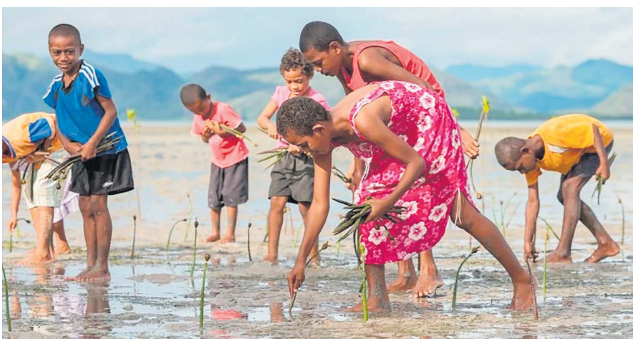THE quiet work of protecting Fiji’s coastlines has taken a big step forward.
For Fiji, the end of the MACBLUE Project feels less like a finish line and more like a moment to look back at how far we have come in caring for our coastlines.
With the work now complete, communities and experts say Fiji is better prepared to plan for the future of these places that keep the people, villages and islands safe.
“These ecosystems are not just part of our landscape. They hold our future,” said Rhonda Robinson, director of the Geoscience, Energy and Maritime Division at SPC.
After years of mapping, planning and working with communities, Fiji is better equipped to care of the coastal areas that help hold back stronger seas and rising heat.
MACBLUE, which began in 2022, has been implemented in Fiji, Papua New Guinea, Solomon Islands and Vanuatu.
It focused on mapping and monitoring mangroves and seagrass meadows, which store large amounts of carbon, support marine life, and act as natural barriers against erosion and sea level rise.
Using Pacific Community’s Digital Earth Pacific platform, governments and researchers gained free access to satellite data to track the health of these coastal ecosystems.
The work included biodiversity surveys, standard carbon measurement methods, training for national experts, and reviews of environmental laws to support stronger governance in the long term.
Permanent Secretary for Environment and Climate Change Dr Sivendra Michael said the project showed how better data and strong policies could protect nature and communities.
“The completion of the MACBLUE Project marks a significant milestone in Fiji’s environmental conservation efforts,” he said.
“This initiative not only supports our national objectives to enhance climate resilience and promote sustainable management of our blue carbon ecosystems, but it also brings attention to the importance of embedding legal and policy frameworks that ensure long-term accountability and enforcement.”
SPREP director of Biodiversity Conservation Amena Yauvoli said the project has helped countries better understand what was at stake.
“This collaborative effort exemplifies our commitment to safeguarding biodiversity and enhancing climate resilience in the Pacific region, as well as addressing a long-standing gap in blue carbon data,” Mr Yauvoli said.
“The blue carbon and carbon stock assessments carried out through this project give us a clearer picture of how much carbon is stored in our coastal ecosystems, like mangroves and seagrasses.
“This information is crucial for shaping national climate policies and helping communities benefit from conservation efforts in the long run.
“It also calls for a collective regional action to continue the momentum on blue carbon projects to strengthen our knowledge and capacity in blue carbon ecosystems.”
Project partners also noted the value of mapping seagrass and mangrove habitats, which guides national planning for coastal protection and climate adaptation.
Ms Robinson said the work on mapping seagrass and mangrove habitats has been especially important.
“It not only helps us understand where these vital ecosystems are located, but also supports efforts to measure blue carbon and guide national planning for coastal protection and climate action,” she said.
Building on this, project director at GIZ, Raphael Linzatti, said the success of the MACBLUE project demonstrated how integrated approaches could effectively address environmental challenges.
“As a committed international cooperation partner, GIZ is proud to support Pacific Island countries in strengthening climate resilience and sustainable resource management,” he said.
“One of the key strengths of this project has been its emphasis on regional collaboration, bringing together countries, institutions, and communities to share knowledge, harmonise methodologies, and build collective capacity.
More than 100 participants across the region have been trained through MACBLUE workshops, including experts in Fiji.
The goal is for local professionals to continue the work long after the project ends.
Partnership has been at the centre of the program. With communities, governments and regional organisations now equipped with clearer data and stronger skills, the Pacific is in a better position to protect the blue carbon ecosystems that hold both climate and cultural value.
Government ministries, regional agencies and international partners gathered in Suva on October 23 to reflect on the project’s achievements and the momentum it has created for environmental protection across the Pacific.



